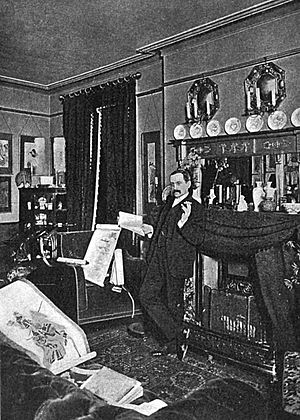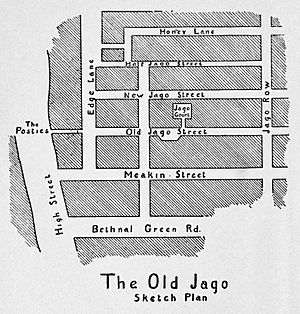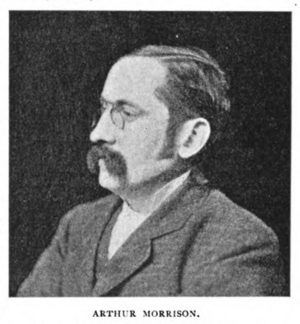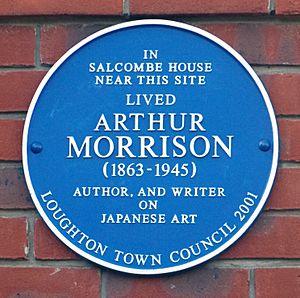Arthur Morrison facts for kids
Quick facts for kids
Arthur Morrison
|
|
|---|---|

Morrison (no later than 1903)
|
|
| Born | 1 November 1863 Poplar, London, England |
| Died | 4 December 1945 (aged 82) Chalfont St Peter, Buckinghamshire, England |
| Occupation | Writer, journalist, art writer, art collector |
| Subject | Detective fiction, working-class life |
| Literary movement | Literary realism |
| Notable works | A Child of the Jago |
| Spouse | Elizabeth Thatcher |
| Children | Guy Morrison |
Arthur George Morrison (born November 1, 1863 – died December 4, 1945) was an English writer and journalist. He was known for his realistic novels and stories about everyday life for working-class people in the East End of London. He also wrote popular detective stories featuring a character named Martin Hewitt.
Besides writing, Morrison was a big collector of Japanese art. Many pieces from his collection are now in the British Museum. His most well-known novel is A Child of the Jago (1896).
Contents
Arthur Morrison's Early Life
Arthur Morrison was born on November 1, 1863, in Poplar, a part of the East End of London. His father, George, worked as an engine fitter at the London Docks. Sadly, his father died in 1871, leaving Arthur's mother, Jane, to care for Arthur and his two siblings.
Arthur grew up in the East End. In 1879, he started his first job as an office boy. He worked in the Architect's Department of the London School Board. Around this time, he often visited used bookstores in Whitechapel Road. In 1880, his mother opened a shop. That same year, Arthur published his first work, a funny poem, in Cycling magazine. He also enjoyed cycling and boxing.
Arthur Morrison's Career as a Writer
In 1885, Morrison began his serious journalism career. He started writing for The Globe newspaper. By 1886, he got a job at the People's Palace in Mile End.
In 1888, he gained special access to read at the British Museum. He also published a collection of 13 short pieces called Cockney Corner. These described life in different parts of London, like Soho and Whitechapel. In 1889, he became an editor for the Palace Journal. He reprinted some of his Cockney Corner pieces there. He also wrote about books and the lives of poor people in London.
Becoming a Full-Time Writer
In 1890, Morrison left his job to join the editorial team at The Globe. He moved to new lodgings in the Strand. His first book, The Shadows Around Us, came out in 1891. It was a collection of 15 supernatural stories.
In October 1891, his short story A Street was published in Macmillan's Magazine. The next year, he worked with illustrator J. A. Sheppard on animal sketches. One of these, My Neighbours' Dogs, appeared in The Strand Magazine. Later in 1892, he married Elizabeth Thatcher. He also became friends with writer William Ernest Henley. Morrison wrote stories about working-class life for Henley's National Observer from 1892 to 1894. His son, Guy Morrison, was born in 1893.
Detective Stories and Famous Novels
In 1894, Arthur Morrison published his first detective story. It featured his detective character, Martin Hewitt. Later that year, he released a collection of short stories called Tales of Mean Streets. This book was reviewed in America in 1896. Morrison later said the book was publicly banned because some reviewers disliked his story Lizerunt. He wrote a response in 1895. Also in 1894, he published Martin Hewitt, Investigator.
In 1895, a clergyman named Reverend A. O. M. Jay invited Morrison to visit the Old Nichol rookery. This was a very poor and crowded area in London. Morrison used what he saw there to write his famous novel, A Child of the Jago. He started writing it in early 1896. The book came out in November that year. It showed the harsh living conditions and violence in the East End, based on the Old Nichol Street Rookery. In 1896, he also published The Adventures of Martin Hewitt.
In 1897, Morrison published seven short stories about another detective, Horace Dorrington. Unlike Martin Hewitt, Dorrington was a "respected but deeply corrupt private detective." He was known for being willing to steal, blackmail, or even commit murder to make money. These stories were collected in The Dorrington Deed-Box in 1897.
Later Works and Art Collecting
In 1899, Morrison published To London Town. This was the final part of a series that included Tales of Mean Streets and A Child of the Jago. He then published Cunning Murrell in 1900 and The Hole in the Wall in 1902. Throughout the 1900s, he continued to write many different types of works. These included short story collections, one-act plays, and articles about Japanese art.
In 1906, he sold a collection of Japanese woodcuts to the British Museum. He also wrote a play with his neighbor, Horace Newte. Morrison lived and wrote in areas like Chingford and Loughton.
Arthur Morrison's Later Life
In 1906, Arthur Morrison gave about 1,800 Japanese woodblock prints to the British Museum. In 1911, he published an important book called The Painters of Japan. This book included paintings from his own collection. A sixth edition of A Child of the Jago was also released that year.
In 1913, he stopped working as a journalist. He moved to a home in High Beach in Epping Forest. That same year, Morrison sold his collection of Japanese paintings for £4,000 to Sir William Gwynne-Evans, who then donated them to the British Museum.
On January 7, 1914, Morrison was part of a special event. He was a jury member in a pretend trial of John Jasper for the murder of Edwin Drood. This event had many famous people, including G. K. Chesterton as the Judge and George Bernard Shaw as the jury foreman.
Morrison's son, Guy, joined the army in 1914 to serve in World War I. In 1915, Morrison became a special police officer in Essex. He was known for reporting the first Zeppelin air raid on London. He also continued to publish books about art. Sadly, in 1921, Guy Morrison died from malaria. In 1924, Arthur Morrison was chosen to be a member of the Royal Society of Literature.
In 1930, Morrison moved to his last home in Chalfont St Peter, Buckinghamshire. In 1933, he published a short story collection called Fiddle o' Dreams and More. In 1935, he was elected to the Council of the Royal Society of Literature. Arthur Morrison died in 1945. In his will, he left his collection of Japanese paintings, prints, and ceramics to the British Museum.
Arthur Morrison's Legacy
The Arthur Morrison Society was started in 2007. It began with a public reading at Morrison's grave. Since then, the society has held talks and events as part of the Loughton Festival. These have included a talk by Tim Clark from the British Museum about Morrison's Japanese art collection.
There is a blue plaque dedicated to Arthur Morrison. It is near where his house, Salcombe Lodge, once stood in Loughton. On April 28, 2019, an actor named Robert Crighton read two of Morrison's detective stories at Loughton Baptist Church. This church is very close to where Salcombe Lodge used to be.
Literary Works
- The Shadows Around Us (1891)
- Tales of Mean Streets (1894)
- Martin Hewitt, Investigator (1894)
- Zig-Zags at the Zoo (1894)
- The Chronicles of Martin Hewitt (1895)
- The Adventures of Martin Hewitt (1896)
- A Child of the Jago (1896)
- The Dorrington Deed-Box (1897)
- To London Town (1899)
- Cunning Murrell (1900)
- The Hole in the Wall (1902)
- The Red Triangle (1903)
- The Green Eye of Goona - The Green Diamond (US title) (1904)
- Divers Vanities (1905)
- Green Ginger (1909)
- Fiddle o'Dreams And More (1933)




